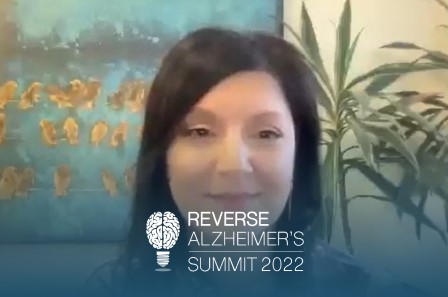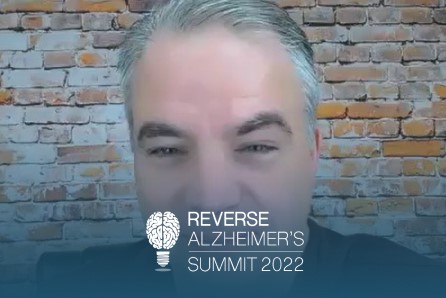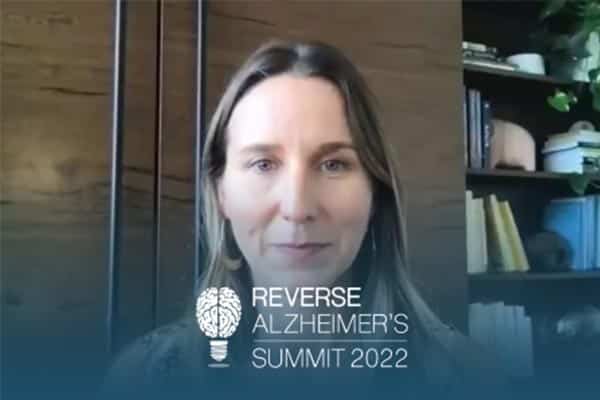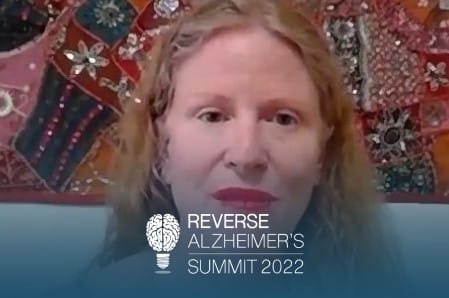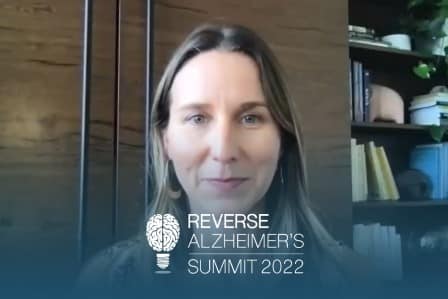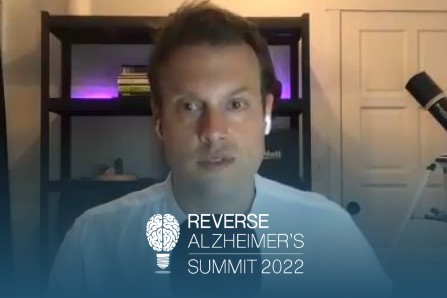Join the discussion below

Dr. Heather Sandison is the founder of Solcere Health Clinic and Marama, the first residential care facility for the elderly of its kind. At Solcere, Dr. Sandison and her team of doctors and health coaches focus primarily on supporting patients looking to optimize cognitive function, prevent mental decline, and reverse... Read More

Nafysa Parpia, ND has an independent practice at Gordon Medical associates, specializing in the treatment of Lyme disease and other complex chronic illnesses such as autoimmunity, mold toxicity, fibromyalgia, environmental toxicity and gastrointestinal disorders. Her patients with chronic Lyme Disease are typically those who either do not do well with antibiotics, or prefer... Read More
- Learn the symptoms of tick-borne illness.
- A step wise approach to treating complex chronic illness.
- Treating cognitive decline includes assessing for tick-borne disease.
Related Topics
Alzheimers, Brain, Brain Health, Chronic Illness, Hormone Health, Lyme, Mast Cell ActivationHeather Sandison, N.D.
Welcome to the Reverse Alzheimer’s Summit. I’m your host, Dr. Heather Sandison. And I’m so delighted to have my friend and colleague, Dr. Nafysa Parpia here today. She has spent the last decade treating patients with complex chronic illnesses from all over the US and really all over the world. She specializes in tick-borne illness, environmentally acquired illness, mold mycotoxin illness, autoimmunity, fibromyalgia, and chronic fatigue syndrome. She uses cutting-edge lab tests and deep intuition applied to the full range of scientific data to create comprehensive treatment plans that are highly personalized. You can see why I’ve invited her here today. She is also reversing irreversible diseases. And has a clear understanding of how toxins and other complex issues affect the brain. Welcome.
Nafysa Parpia, N.D.
Thank you, Heather. It’s so nice to be here.
Heather Sandison, N.D.
So let’s dive right in. What kind of background or history or symptoms might make you suspect like a tick-borne disease, or mycotoxins, or any of these things that you really delve into? What makes you think that that might be part of what a patient is suffering with?
Nafysa Parpia, N.D.
That’s a great question. So a lot of my patients are gonna have issues with autonomic dysregulation. So they have inflammatory chemicals that are affecting the vagus nerve. And we see that frequently in Lyme. So they’ll have problems also with… Go straight to the cognitive problems actually. They’ll have problems with memory, reading comprehension, controlling their moods, or a lot of mood swings, sleep problems, hormonal issues, and then the autonomic dysregulation. And that lets us know that there’s definitely a correlation here. With some infection typically it is a tick-borne disease. And so then with the autonomic dysregulation, we have these inflammatory chemicals that affect the vagus nerve. And so we’re talking about diseases that have neurotoxins like Lyme or mold. And so we see this frequently with Lyme. So not only do they have brain fog and cognitive decline but they have a host of other autonomic dysregulation symptoms also.
Heather Sandison, N.D.
Things like really fast heart rate or feeling dizzy, or also even it affects the GI tract. I think that this is one of the reasons why these diseases are so complicatedly. Is they affect every system in the body. And then-
Nafysa Parpia, N.D.
Exactly.
Heather Sandison, N.D.
It’s hard to figure out where it’s coming from.
Nafysa Parpia, N.D.
Right. So a lot of them will have issues with the heart. Just like you said, they’ll have a rapid heart rate, or they’ll have POTS, or their heart beats really, really fast in their chest. And of course I send them to… Excuse me. Of course, I send them to a cardiologist for a workup. And then typically, the cardiologist says there’s nothing wrong that this is not about your heart. So usually, it has to do with inflammation. It’s about neurological effects. And inflammation affecting the nervous system. So these patients also have shortness of breath. They have anxiety, poor stomach emptying like you said. Chronic constipation. So all of this can be autonomic nervous system. And so then what I’m seeing is that these patients who have all of these symptoms, plus they have cognitive decline. Then that’s what I’m thinking, chances are, there’s a tick-borne disease underneath this. But now it’s never just Lyme, it’s usually coinfections. And it’s never just Lyme and coinfections, it’s usually other bugs, meaning viruses, parasites, bacteria, and it’s usually a host of environmental talks. And so it’s this soup of things that are causing neuroinflammation.
Heather Sandison, N.D.
So where do you even start? I know that so many patients that present this way feel overwhelmed and they don’t feel good at all. And so getting started can often be one of the biggest hurdles. What do you advise patients to do?
Nafysa Parpia, N.D.
Yeah. So first I start with modulating their immune system. And it was difficult to do that before the advent of peptides. but now I use a lot of peptides therapies to begin to modulate their immune system. So these patient are already inflamed. They’ve got the neuroinflammation like we talked about. We see that on labs. I see that on the Cunningham Panel or the Neural Zoomer Plus panel. And they have a high environmental toxin load. And so I wanna start by modulating the immune system, because I know that if I start to kill infections first which is very often where the patient wants to go first, or I start to detox first, then I’m creating more inflammation in the body. It’s just, that’s just a byproduct of detox or killing infections. So I want to modulate the immune system first so the patient is able to handle the upcoming kill of infections and detoxification. So modulate the immune system first with peptides, and then I will treat mast cell activation syndrome ’cause usually my patients do have that. And so the mast cell activation syndrome is secondary to the drivers which is the infections and the toxins.
Heather Sandison, N.D.
That makes a ton of sense. Just setting people up for success. So creating those foundations so that they can get the most out of whatever interventions like the bug killing or the detox that comes next. And also be able to just get through that with a little bit smoother process. We both have heard for years, the stories of people just going through, feeling terrible to start, and then going through hell as they try to treat these complex diseases. And that if we can set them up for success, they are so much more likely to cross that finish line, really feel better and also even feel better along the way.
Nafysa Parpia, N.D.
Exactly. So a lot of think that they should feel bad. When they’re killing an infection, they say, “oh, I’m just herxing, doesn’t that mean that we’re killing the infection?” And I say, yeah, it doesn’t mean we’re killing the infection, but I don’t want that effect. There’s often damage happening to the mitochondria. Is not just a Herx, what we thought of as Herx in past years realizing that’s actually, mast cell activation syndrome. So we can get people in a mast cells flare that doesn’t stop if we keep pushing them and they think, oh, it’s just a kill that’s not the case we need to dial it back down and really work on the foundation again. So again, it’s immune modulation, mast cell activation treatment. I’m also working a lot on their hormones. It could be their sex hormones. It could be their thyroid. A lot of times they have GI and malabsorption issues, constipation SIBO. These patients don’t do well on detox or killing infections. So we have to set the stage, like you said, to get them ready for the big guns in treatment. So this can take a long time. But with peptides actually, these treatments have become way faster.
Heather Sandison, N.D.
It’s so exciting. So what are your go-to peptides? Is this like thymosin alpha 1? BPC? What else do you use? And how do you use them? How do you decide which ones are best for which people?
Nafysa Parpia, N.D.
Yeah, so I start with… Usually, I start with the trio BPC-157, TB4 Frag, and KPV. So BPC-157 for cellular repair to bring down inflammation in the gut and also throughout the whole system. TB4 Frag to modulate the immune response. And KPV to help with mast cell. Also, if they have mast cell issues, I’m adding in amlexanox to begin with also. Then I might add in Ta1. We don’t have Ta1 available anymore, but when I did, I would add it in later. What I found out, is that when people… A lot of people would’ve come into me maybe already on Ta1 and it backfired and that’s because it’s already kicking up an immune storm. It’s starting to help the patient kill an infection. But we don’t wanna start that kill first and especially if somebody already has autoimmune diseases, you bring in something like Ta1, it’s gonna kick that up. So timing is so important. So I start with the trio usually, TB4 Frag, KPV and BPC-157. And then I’m gonna give mast cell support with herbs or H1 or H2 blockers or mast cell stabilizers. Could be drugs, could be herbs. And then, could be a peptide, KPV or amlexanox. And then there’s other peptides I used to kill LL-37, Ta1 if I could get it again.
Heather Sandison, N.D.
Well that’s such a crucial I think point is just this order of operations. What do you do first? What do you do next? And a lot of that is very individualized I’d imagine. So with each patient, as you go through this process I’m sure you’re reevaluating what they need next. So there’s kind of a formula, but we tweak it as that individual comes through the process.
Nafysa Parpia, N.D.
Right. And one thing I didn’t talk about is how we evaluate speaking of order of operations that’s the first thing I do. So I’m gonna take a very clear history and then I’m gonna do a bunch of laboratory work based on what I hear. So our clinic is involved with the work of Dr. Bruce Patterson, for long COVID. And so he’s developed a panel for inflammatory cytokines. Now, whether someone had has long COVID, or whether they have post-treatment Lyme disease, or any other complex chronic issue, they’re still gonna have high inflammatory cytokines. So this panel’s appropriate for anybody who walks through our doors. So I’m testing their inflammatory cytokines and I’m testing infections. So now we can tell if somebody has a current tick-borne infection or not, where in the past we just have to use antibody tests, which tell us about the past. But now, I know about right now using the T-cell tests, looking interferon gamma and Interleukin 2. And then also looking for the environmental toxin, glyphosate, heavy metals, other toxins, testing their gut, if their gut is an issue, usually it is of course they’re hormones. So really it’s doing… It’s like when people go and get an MRI or scanning for their whole body instead of an MRI, and I know you do this too. We’re looking at the biochemistry of the whole body.
Heather Sandison, N.D.
Yeah, taking a complete scan of what are all things that we know impact cellular function. How can we systematically go through it and say, okay, yep, that one’s hurting you. Yep, that one’s helping you. You have enough or you don’t have enough. And then we can be very specific. And I appreciate this about what you’re describing. When we know that RANTES is elevated versus IL-10 or IL-6. We can make different decisions about treatment interventions and get more precise. And then we can expect better outcomes.
Nafysa Parpia, N.D.
Yes, exactly. And I love to look at their genes. There’s certain genetic tests I like it’s called IntellxxDNA. And so use that one too? Yes.
Heather Sandison, N.D.
Yes. Sharon Hausman-Cohen developed that. And yeah, she’s also featured on the summit. And yes, can give us that precision medicine, that view of what’s going on for that individual.
Nafysa Parpia, N.D.
Yes, because it’s looking… I love that test ’cause it’s looking at combinations of genes instead of just one snip, but what genes are combined and what effect could they have on possible illnesses. So then when you marry that information with what’s showing up on their biochemistry, there’s a little bit more of a predictive factor never to use genes to diagnose anything, but to confirm what we know or to confirm what we… A confirmation that we’re looking for but we’re not quite clear on. So…
Heather Sandison, N.D.
Yeah, it definitely helps us like probability and risk. And I think it also helps people feel the story is clear, like you’re saying, confirmation that like all right, it’s all adding up. The data over here matches the data over here which matches my symptoms and my experience.
Nafysa Parpia, N.D.
Exactly.
Heather Sandison, N.D.
And then it feels really good to start a plan. When so many people unfortunately, the people that we tend to see are complex chronic illness patients. And even in my case, dementia patients, they show up to a conventional doctor and they’re told, there’s not really much we can do. Your labs look great. We can-
Nafysa Parpia, N.D.
We can just… Yeah, looking at the basic labs, which will tell us if a patient is maybe dying or not. But our patients are not that category. They’re just really, really suffering. And that’s not gonna show on the standard basic labs.
Heather Sandison, N.D.
Yeah, look for those imbalances and then fine tune and optimize. ‘Cause our patients show up wanting to be healthy.
Nafysa Parpia, N.D.
Yes. And then they’re so happy when they finally have a diagnosis. Like why are you diagnose me with that? They’ve been to five doctors at least, sometimes 20, sometimes 50, before they come to either of us. And no diagnosis or misdiagnosis or you’re just aging, it’s just genes.
Heather Sandison, N.D.
Right. You just have to kind of suck it up and get through it. It’s so sad. And I know you and I are both very dedicated to reducing the suffering. This suffering that doesn’t have to happen. That there are solutions. In fact, sometimes it gets almost overwhelming with how many solutions there are. So you kind of spelled out the beginning. Take us through an entire treatment protocol. So you definitely wanna start with reducing inflammation, modulating the immune system. And then we kind of… As you get mast cells under control, we’re going towards detoxification and treating bugs. What happens after that? Are we cured?
Nafysa Parpia, N.D.
Well, some people are. Some people I don’t even have to kill their bugs if I modulate their immune system and I detoxify them. They’re killing their bugs. Their immune system is set up to kill the bugs on their own. Some people that’s not the case. And so now every time I’m killing an infection, I’m always detoxifying because when me killing an infection, there’s byproducts of dying cells, dying bugs. And parasites and moles they sequester metals. So when we kill those, there’s gonna be higher metals in the system. So we’re always keeping this balance. It’s very much a dance with each patient. Now that really good question you ask, after that are we done? Well, very often, these infections and these toxins, they set up a pattern of immune dysregulation or neuroinflammation. So we can remove the inciting event, but the patient still has a pattern of an inflammatory response or neurological response.
And like I alluded to maybe 10 minutes ago, maybe in the past, I would’ve said, all right, let’s write an antibody test or a PCR test even and let’s see. If you have tick-borne disease now I can say, let’s run the T-cell test. Do you actually have tick-borne disease? It turns out often that even after an infection is killed and we can confirm that finally with this T-cell test it’s by Infectolab. They’re not done because they still have some symptoms. And that’s when the patient is stuck in them loop of neuroinflammation or immune dysregulation. Usually those go hand in hand so now we have to figure out where are we gonna break that loop? How are we gonna do that? That’s when I start to use regenerative medicine. So more peptides, maybe exosomes, other-
Heather Sandison, N.D.
Yeah, there’s a lot of amazing things that are available to rebuild because that damage has been done by those infections and those toxins. And so just getting rid of them isn’t always enough.
Nafysa Parpia, N.D.
Right. The mitochondria can be stuck in the loop of inflammation. This is so dangerous process. That’s a whole another topic we can talk about another day. But there’s so many areas where the body gets stuck even after we remove the insults. And we have to remove those insults. But do you remember at school, they always taught us, remove the trigger and the patient’s gonna get better? But what I know you and I have both learned is, it’s not always the case. We do have to remove the triggers. There’s a lot more else that we need to do. Structural integrity, is a big issue as well. So sometimes we What was that?
Heather Sandison, N.D.
How does structural integrity show up in your model?
Nafysa Parpia, N.D.
Yeah. So, I wanna bring it back to cognitive decline. So a lot of my patients will have structural integrity issues in the neck. Maybe they have craniocervical instability or their neck is just really out of alignment. It’s very often that there’s something wrong with their teeth and their jaw and the sinuses as well. So then they have neuroinflammation. Now, inflammatory cytokines, they end up getting stuck. They end up accumulating in these areas. Because they’re swelling now that decreases the blood flow that decreases the lymphatic flow and that’s irritating the nerves. So not only that but that there’s inflammatory cytokines which can cross the blood-brain barrier via the olfactory nerve, or just even through the cribriform plate in the brain that connects to the sinuses. And so now stress for integrity issues with somebody who has inflammation through a tick-borne disease or which is what we’re talking about today. But other infections as well, can cause further issues in cognitive decline, which is actually quite reversible. So we have to clean up the jaw, work on the sinuses, work on the neck, and it’s gonna help a lot with the cognitive decline which is really downstream… Downstream from that is the inflammation. integrity.
Heather Sandison, N.D.
This is such a hopeful message. Is that there’s something that we can do about it. And there’s certainly if somebody is suffering with cognitive decline, and they’re fearful of developing dementia, that there is a way that we can systematically approach this and look for the things that might be causing that inflammation and the inflammation might be what’s causing the cognitive decline. So take us through maybe a couple of cases that you’ve seen in your clinic where you’ve seen this sort of happen.
Nafysa Parpia, N.D.
Are you talking about the cognitive decline piece?
Heather Sandison, N.D.
Yeah. Or any cases where you’ve seen something where people weren’t getting better and all of a sudden… Or maybe through your process somebody was transformed.
Nafysa Parpia, N.D.
Yeah. So, I’m gonna talk about somebody who came to our clinic from another country with ALS. So he first… And along with the ALS came a lot of brain fog. And what he thought was cognitive decline. He was a men in the 60s, and he came. And he had Lyme disease. Now his Lyme was treated in… By Lyme-literate doctor in his country. And then he came to us thinking he still has Lyme and wanting treatment for ALS of course. Now I did the T-cell test to see if he does indeed have Lyme. And boy, was his body acting like he had Lyme? He had all the telltale signs. The brain fog, the neurological issues, I mean the whole thing… The pain. So we thought, well, maybe the Lyme and the other tick-borne diseases have not been treated yet. Well, let’s test that. Oh my goodness. They have been treated. There is no Lyme active here in this man. Okay. So what else? What else is going on that’s causing inflammation? So this was prior to the availability of the cytokine panel that I left that Dr. Bruce Patterson developed. So we didn’t test inflammatory cytokines yet, but I did test toxins.
Mercury was through the roof. So he had mercury that was high unprovoked, as well as a high body burden which I saw that was provoked. And not only that, but he worked and he lived in an area where there was a lot of environmental toxins and right near a golf course. Glyphosate was higher than I’ve ever seen in anybody hands down. So the good thing is we didn’t kill infections because we didn’t need to kill those infections. And so I did a lot of detoxification for him. So heavy metal chelation, as I chelated him, I saw that the vesiculations in his body started to decrease. By the way he came to us in wheelchair. We gave him a lot of phosphatidylcholine IVs to help with the nerves and to help with detoxification. And so he was doing these IV treatments two times a day, four days a week, for… I can’t remember if it was two or three months but two or three months. I think it was three months actually. And then we gave him exosomes. By the end of it, he was able to get up out of a chair on his own.
Heather Sandison, N.D.
Wow.
Nafysa Parpia, N.D.
He was able to walk down the hall and through the parking lot where before he couldn’t take a step on his own at all, wheelchair bound. His arms were in like this. He was suddenly gesticulating. He used to talk really, really slow. He couldn’t swallow liquids well, that was gone. And then his mental functioning was starting to come back. Now, there’s a piece that’s not treated. And by the way, he’s not better. He needs more treatment. He’s still has to be in a wheelchair a lot. But he’s so much better in just three months of treatment. I mean so much better. And so he… He has a bunch of cavitations. And so he needs dental work which he’s gonna be getting soon. And I have a feeling that’s gonna even… That’s gonna lift the cognitive stuff even more than the other therapies already did. So he’s somebody who just with three months of treatment, significant changes and still has a ways to go. But it was just so rewarding to be-
Heather Sandison, N.D.
That is incredible. And so inspiring to all of us to hear these miracle stories. It’s like we know that this is possible. And I hope what it inspires people to do even more than getting help, it’s getting help early. Like going to good doctors who think through these concepts and who can put the treatment plan in the right order and appreciate the complexity of the disease process. And all of the different things that are going on. The cytokines and the toxins, and the tick-borne diseases, and all of these pieces. And the importance of sleep and dental work and all of these components that we really have to hold. It’s a lot. It’s not as simple as just writing a prescription for one pill. It really is about this harmony between all of the systems and hearing that ALS has been reversed essentially. And yeah, of course, he’s not a 100% better after three months, which would be amazing too. We all want that. Fact that he can recover as much function as he did. Imagine if he had seen you two or three years ago at the symptoms.
Nafysa Parpia, N.D.
Those people can be turned around like that. And nobody can believe it. But they can be the people who come at the beginning. We can turn that
Heather Sandison, N.D.
So much easier, so much simpler, so much less expensive. And so I wanna encourage everyone to get help early. Things like dementia and ALS and Parkinson’s and MS. All these neurodegenerative diseases. The sooner we can figure out what those trigger are and get rid of them, the faster you get better. And so imploring people like don’t make us your last stop.
Nafysa Parpia, N.D.
Exactly. You don’t need to be the 20th doctor. Come now, ’cause we can shift this.
Heather Sandison, N.D.
So exciting. So I want our participants here to understand how to find out more about you. And where they can go. Are you seeing patients? What’s going on at your clinic and where-
Nafysa Parpia, N.D.
Yeah. So we’re in the San Francisco Bay Area. We’re in Marin County in San Rafael. But people come from all over the country, even other parts of the world to our clinic. They come and they stay at a local Airbnb, or a local hotel or they do a long term… A short term rental, sorry, nearby. And they come and they get a lot of intensive treatments at our clinic. And so the website is www.gordonmedical.com. And so I am seeing you patients, and we have of course, Dr. Eric Gordon. It’s his clinic. He’s also seeing patients and Dr. Jamie Kunkle, is also on board with us. I think you know Jamie, he went to school with us.
Heather Sandison, N.D.
Yeah, of course. And he’s a very Lyme-literate doctor. Very, very well informed, super smart guy. Yeah. That’s great. I mean, you guys make it incredible team all three of you. I know and love and appreciate. And then you are also the host of the Mycotoxin And Chronic Illness Summit. And so people can also head over to that summit. And although it’s not available for free right now, it is available to purchase the recording. So if you have additional questions about this or you have additional interest and you think that this might be part of what is contributing to your cognitive decline. I highly recommend that you check out Nafysa and Eric’s summit as well.
Nafysa Parpia, N.D.
Thank you, Heather.
Heather Sandison, N.D.
Of course, of course. It’s been such a pleasure. It’s always a pleasure connecting with you.
Nafysa Parpia, N.D.
Always, always so much fun.
Heather Sandison, N.D.
Now I’ll be looking forward to the next time. Thank you for sharing your time and expertise.
Nafysa Parpia, N.D.
Thank you so much for what you’re doing Heather. So excited.
Downloads

